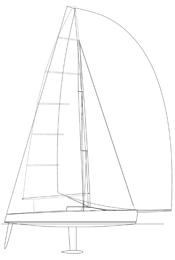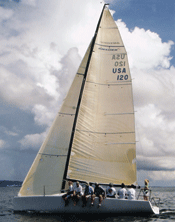Melges 32
2006 January 12
New one-designr
 For 15 and one half years I brought my dog Piper to work with me every day, but two weeks ago she let me know she just didn't have the energy anymore. In fact, she could no longer stand up. I lied my best lie to her and told her it was OK and I'd be all right without her. She was the best boat dog ever and I sorely miss my devoted companion.
For 15 and one half years I brought my dog Piper to work with me every day, but two weeks ago she let me know she just didn't have the energy anymore. In fact, she could no longer stand up. I lied my best lie to her and told her it was OK and I'd be all right without her. She was the best boat dog ever and I sorely miss my devoted companion. Now to the task at hand, and a look at this fantastic new 32-footer from Melges. This is a high-powered, muscular rocket of a boat designed for very aggressive one-design racing. The design is by Reichel/Pugh, which has been designing some of the world's fastest boats lately. So with a team like Melges and R/P we can only expect a true leading-edge product. The Melges 32 is produced in Trinidad by SOCA Boats.
 With a D/L of 75.21 you get an idea that this boat is long and light. But in a case like the M32 this needs a caveat. Crew weight is a huge part of the performance package for a boat like this, so let's plug some crew weight numbers into our D/L formula. Assume you are racing PHRF with a crew weight of 1,480 pounds. That's a crew of eight 185-pound men or ten 145-pound women. Now, using the static DWL of 28.5 feet, we have a D/L of 103.7. This is not a correct number because as you add crew weights the boat sinks and the DWL increases, but without an accurate pounds-per-inch immersion number I can't tell just how much the DWL increases. But you get the idea.
With a D/L of 75.21 you get an idea that this boat is long and light. But in a case like the M32 this needs a caveat. Crew weight is a huge part of the performance package for a boat like this, so let's plug some crew weight numbers into our D/L formula. Assume you are racing PHRF with a crew weight of 1,480 pounds. That's a crew of eight 185-pound men or ten 145-pound women. Now, using the static DWL of 28.5 feet, we have a D/L of 103.7. This is not a correct number because as you add crew weights the boat sinks and the DWL increases, but without an accurate pounds-per-inch immersion number I can't tell just how much the DWL increases. But you get the idea.  The topsides are quite flat and flared. The entry is fine and the stern is not overly broad. I do not have hull lines for the 32 and given the nature of the project I don't expect to get them despite my phone call. The sheer is reversed. This means that instead of being a concave sheer spring it is convex, with max freeboard around the mast and being about the same as the freeboard at the stem. This was done years ago by the Northwest's own tragic designer Ben Seaborn. Tom Wylie likes reverse sheers. You could argue that by reversing the sheer you strengthen the boat longitudinally. The 7-foot-draft keel retracts through the companionway hatch and the rudder is a Vara rudder that pulls out of the hull for trailering. With the Vara rudder the entire rudder blade slides into a bearing with a diameter larger than the chord length of the rudder blade.
The topsides are quite flat and flared. The entry is fine and the stern is not overly broad. I do not have hull lines for the 32 and given the nature of the project I don't expect to get them despite my phone call. The sheer is reversed. This means that instead of being a concave sheer spring it is convex, with max freeboard around the mast and being about the same as the freeboard at the stem. This was done years ago by the Northwest's own tragic designer Ben Seaborn. Tom Wylie likes reverse sheers. You could argue that by reversing the sheer you strengthen the boat longitudinally. The 7-foot-draft keel retracts through the companionway hatch and the rudder is a Vara rudder that pulls out of the hull for trailering. With the Vara rudder the entire rudder blade slides into a bearing with a diameter larger than the chord length of the rudder blade. If we calculate SA/D we probably need to include crew weights again. This is not a Tartan 34. If you race one-design you will carry a crew of seven people max and if you go PHRF that rule will limit you to the 1,480- pound limit, so we will use that number again to bring our displacement up to 5,380 pounds. With working 105-percent jib and using actual sail area rather than I, J, E and P, we get an SA/D of 36.42. Just for fun let's back the crew weight out of the displacement. Now the SA/D soars to 45.14. But, by any reasonable standard, 36.42 is a lot of sail area as evidenced by the photos I have seen of the 32 carrying crews of eight and nine men with the bulk of the crew on the rail, legs outboard. But wait, there is more. For off the wind speed you can fly a masthead, 1,302-square-foot asymmetrical chute.
This is not a Mom and Pop proposition.

Comments